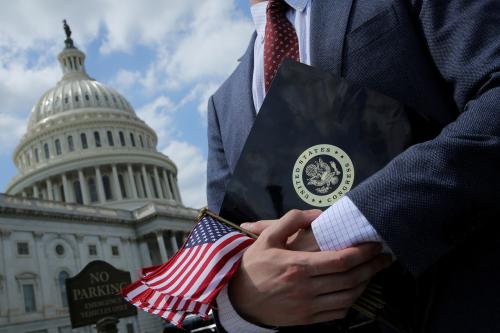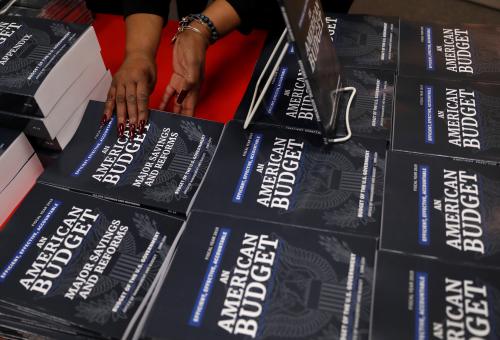The brinkmanship surrounding threats of a year-end federal government shutdown underscores once again the need for budget process reforms. There is broad agreement that we need a process that leads to budget-making that is timely and predictable, and addresses national priorities and dangerous levels of federal debt.
The question is: how can Congress agree on process changes, given today’s polarization and deep distrust between the parties?
In early 2018, as part of the budget deal for that year, lawmakers tried an indirect route to find agreement – empower a special bipartisan, bicameral congressional body to take the lead in negotiating a set of reforms, and send these as a package to Congress.
The Bipartisan Budget Act of 2018 created a Joint Select Committee on Budget and Appropriations Process Reform (JSC), comprised of 16 sitting members of Congress. The JSC was strictly bipartisan and bicameral, with equal numbers of Republicans and Democrats from each chamber. Their task was to come up with a package of budget process reforms by no later than November 30th. To serve as the Committee’s official proposal for reform (and be considered under certain specified procedures in the Senate), the recommendations had not only to win majority support in the JSC, but also majority support among the Democrats and Republicans on the Committee. With that level of bipartisan support, the strategy was that the reform package could line up the congressional votes needed for final passage in both chambers.
Early Momentum – A Last Minute Obstacle
Despite this high bar for success, the JSC members and staff made considerable progress through the summer and fall, building trust and zeroing in on some potentially important reforms; these included putting the budget resolution onto a biennial calendar, and reforming the budget committees. During this period, the JSC considered many budget process reform ideas and solutions, including testimony from outside organizations such as the Bipartisan Policy Center, the Committee for a Responsible Federal Budget, and Convergence. The fact that there needed to be bipartisan support within the JSC, however, necessarily limited the scope and magnitude of reforms that realistically be considered. When the JSC reconvened after the mid-term election, and the Committee began to mark up its final recommendations, the members agreed on several amendments with near unanimous support, including a Fiscal State of the Nation address by the Comptroller General of the Government Accountability Office and the addition of tax expenditures as a category to be outlined in the budget resolution.
At the eleventh hour, however, events outside the JSC torpedoed the Committee’s ability to crown its success with a final vote that met its threshold requirements. The central problem was that Senate leaders Mitch McConnell (R-KY) and Chuck Schumer (D-NY) could not agree on how the Senate would take up, and potentially amend, the JSC’s report. That led Democrats in the JSC to fear amendments being introduced in the Senate that would undermine their agreements with Committee Republicans. As a result, all but two Democratic JSC members pulled their support for the final JSC package.
What does this episode say about using special or independent bodies – such as commissions or select committees of Congress – as a model to pave the way for bipartisan budget reform legislation? Was the design of the JSC a failure?
Lessons from the Past
While there was disappointment, of course, that the JSC did not succeed in delivering a bipartisan reform package that could be enacted in the “lame duck” Congress, in many ways it is remarkable in the current environment that it came so close to doing so.
In our earlier research reviewing the history of budget-related independent commissions and other special bodies, we drew four lessons that should guide the design of a body like the JSC. Here’s how the JSC scored.

1. There needs to be broad public and political agreement on the reason for the commission and its goals.
YES.
The 1981 Greenspan Commission on Social Security, and the series of Base Realignment and Closure Commissions (BRAC), succeeded because their congressional architects understood the importance of broad support for a commission’s goals. By contrast, the Medicare Commission in 1997 fell short in large part because improving economic conditions and public skepticism about the need for Medicare benefit changes undercut a possible commission consensus.
In the case of the JSC, the design and purpose did reflect the feeling in Congress that a fresh approach was needed to achieve budget process reform. There was also wide public frustration with gridlock and threats of government shutdowns, and widespread expert agreement that Congress needed to improve budgeting procedures.
2. Membership selection and voting rules matter for success.
YES.
BRAC and other commissions carefully chose members and set majority voting requirements for a formal agreement to build political momentum for congressional passage of the recommendations. High voting thresholds are a calculated risk, of course, and some promising commissions foundered by aiming too high. Examples include the Simpson-Bowles Commission that had a higher-than-usual passage threshold (14 out of 18) and ultimately fell three votes short. Similarly, the 1997 Medicare Commission’s threshold (11 out of 17) also turned out to be too high, falling one vote shy of passage beyond the Medicare Commission.
The JSC, by contrast, was on track to meet its high bar (10 out of 16, with at least 5 Democrats and 5 Republicans) before it encountered the Senate leadership obstacle. Members from both parties lined up behind important reforms after its co-chairs, Representatives Steve. Womack (R-AR) and Nita Lowey (D-NY), set a professional and civil tone through the hearings and discussions. Had the way been open in the Senate, such as through a unanimous consent agreement that specified particular amendments could be offered, the resulting bipartisan and bicameral vote would likely have gained strong support for passage in Congress.
3. Procedures for turning recommendations into law require enormous care.
YES and NO.
For commissions to succeed, the process for turning recommendations into law must be clear, as it was clearly articulated in the case of BRAC, for instance.
When the JSC was created, there was general agreement by the congressional leadership that if it could reach agreement by November 30, 2018, some form of floor vote was assured before the end of the year. But the drafters of the proposal – perhaps because of the last-minute agreement to create the JSC – did not include procedures that could have been used to force a vote in the Senate. That procedural oversight turned out to be a fatal weakness, even though the Senate could still have considered the report under regular parliamentary procedures.
4. Strong leadership support is needed.
NO.
Commissions like BRAC and Greenspan had solid support from the White House and Congress and that was key to their authority and success. The 1997 Medicare Commission lost its momentum when President Clinton backed away in order to shore up his party support as impeachment loomed. Likewise, the lack of full-throated support from President Obama, and then House Budget Chairman Paul Ryan (R-WI), also helped seal the fate of Bowles-Simpson.
The JSC did have the support of House Speaker Ryan, as well as the leaders of the House Budget Committee, and at least the acquiescence of the White House, but other leadership support was lukewarm. That lack of broad and strong bipartisan leadership support coincided with Majority Leader McConnell’s unwillingness to find agreement with Minority Leader Schumer on how to handle amendments in the Senate, resulting in most JSC Democrats backing out.
What’s Next?
Despite the immediate disappointment, there are reasons to believe that the JSC will have a positive legacy. While some commissions do not lead to immediate reform, they create the foundation for later reform legislation. For instance, President Johnson’s 1967 Commission on Budget Concepts did not lead immediately to legislation, but it laid the foundations for administrative changes and for the overhaul of the budget process in 1974. The JSC has been viewed as a valuable beginning, and its support for biennial budgeting and other steps will help to build momentum for those reforms in the future. Indeed, the Chairman and Ranking House Budget Committee members, Representatives Steve Womack (R-AK) and John Yarmuth (D-KY) immediately introduced a bill containing the budget process reforms of the JSC related primarily to the House. It is much too early, therefore, to say that the JSC was not a success despite its failure to score a home run.
The JSC may also succeeded at another level. In this era of polarization and mistrust, the Committee’s staff and members worked together closely and harmoniously. This success may serve to pave the way for many of its bipartisan ideas to move forward, and for other legislative reform partnerships to advance in the new Congress, either on the floor or quietly through bipartisan caucuses.







Commentary
How can we take partisanship out of the budget process? The lessons from this independent committee can help
December 19, 2018